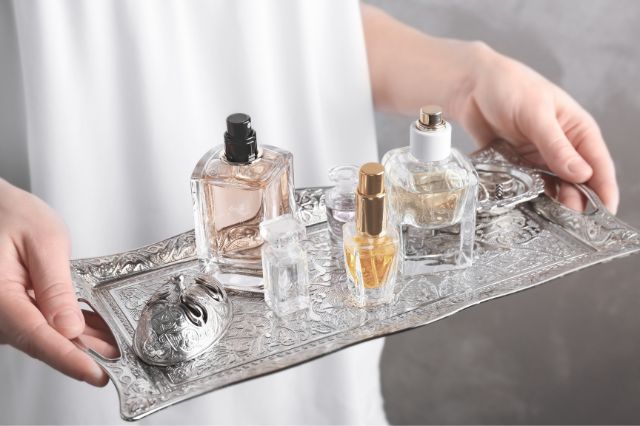Perfume has been a part of our lives for a really long time. It’s not just a nice-smelling liquid; it’s an art, a tradition, and a personal expression.
There are so many perfume options out there, and understanding the different types can help you find the perfect one.
In this guide, we’ll examine the various types of perfumes in order to help everyone find their ideal scent.
Read this useful information in the following sections:
I. Decoding the Fragrance Pyramid
Before delving into the specific types of perfumes, it’s essential to understand the fragrance pyramid, the building blocks that create the symphony of scents. Fragrances comprise three types of notes: top notes, middle notes, and base notes.
The top notes in a fragrance are the first scents you smell when applying it. These notes are usually fleeting and don’t last very long. Typically fresh and light, top notes create the first impression of a perfume.
Middle Notes (Heart Notes) adds depth and character to the fragrance. This is the perfume’s heart, where the true essence is revealed.
The base notes are the fundamental and essential elements that create the foundation of any fragrance. Base notes emerge after the middle notes fade away. They are the lingering, lasting scents that provide the perfume’s overall character and longevity.
II. Understanding Different Fragrance Families
Now, when it comes to choosing a perfume, it’s like picking a flavour you love. Perfumes are divided into different families based on their main smells. Imagine it like different groups of friends, each with its own vibe. Here are the main perfume families:
Floral: These perfumes smell like flowers, such as roses, jasmine, or lilies. They’re often seen as feminine and work well for various occasions.
Oriental: Think rich and exotic. Oriental perfumes use amber, vanilla, and spices, giving off a warm, sensual feeling. They are perfect for special events or a night out.
Woody: Woody fragrances are for you if you like the smell of forests and nature. They use notes like cedar, sandalwood, and patchouli, creating a cozy, earthy scent for both men and women.
Fresh: Fresh perfumes are like a breath of fresh air. They’re light and crisp with notes like citrus, green tea, and aquatic elements, perfect for daytime wear and a clean, revitalizing experience.
Fruity: These perfumes are like a fruit basket in a bottle. They have lively notes of apples, peaches, and berries, giving off a youthful and energetic vibe. They are great for casual and daytime use.
Citrus: Bright and zesty citrus fragrances feature notes like lemon, orange, and bergamot. They are invigorating and perfect for a refreshing burst of energy.
III. Perfume Concentrations
Now, let’s talk about concentration. Imagine perfume like a cup of tea; some are strong and light. Perfumes have different concentrations of smelly stuff, affecting how long they last and how strong they smell. Here’s a quick rundown:
Eau de Cologne is like a light tea. Its lower concentration (usually 2-4%) makes it refreshing and perfect for casual daytime wear.
Eau de Toilette isa bit stronger than cologne. This one has a concentration ranging from 5% to 15%. It’s like your regular cup of tea—just the right balance for everyday use.
Eau de Parfum is a bit like strong, black tea. With a higher concentration (15-20%), it lasts longer and has a more intense smell. It is great for special occasions or evenings.
Perfume Extract (Extrait de Parfum) is like an espresso of perfumes. It has the highest concentration (20-30%) and gives you a powerful and long-lasting fragrance. It is reserved for formal events and luxury experiences.
IV. Seasonal Considerations
Just like you change your wardrobe with the seasons, it’s good to change your perfume, too. Different scents go well with different times of the year:
Spring- Think of flowers blooming. Light, floral, and fresh scents match the blossoming vibe of spring.
Summer calls for freshness. Citrus, aquatic, and green notes provide a cool and refreshing experience during the hot months.
Autumn- As the leaves change, so can your perfume. Woody and spicy fragrances complement the crispness of autumn, giving a warm and comforting feel.
Winter is all about warmth. Rich and wealthy oriental scents and deep woody notes add coziness and sophistication to the cold season.
V. Gender and Unisex Fragrances
Traditionally, perfumes were labelled as either for men or women. But times are changing! Unisex perfumes are becoming more popular.
These are scents designed for everyone, regardless of gender. So, don’t be afraid to explore and find a scent that speaks to you.
VI. Niche vs. Designer Perfumes
When you walk into a store, you might see perfumes from big fashion brands (those are called designer perfumes) and others from smaller, specialized houses (those are niche perfumes). Both are great, but they offer different experiences.
Designer Perfumes are like the popular kids in school—the big names you recognize. They’re available in most stores and cater to a broad audience.
Niche Perfumes are like hidden gems—the unique, special ones. Crafted by smaller houses, they offer exclusive scents for those seeking something different and luxurious.
Conclusion
Perfumes are like a personal signature, expressing your style, personality, and mood.
By understanding the basics of fragrance families, concentrations, seasonal considerations, and the evolving world of unisex and niche perfumery, you’re equipped to embark on a fragrant journey.
So, whether you’re into the timeless beauty of floral scents, the exotic charm of oriental fragrances, or the freshness of citrus notes, there’s a perfect perfume waiting to become a part of your unique identity.
Happy exploring!













